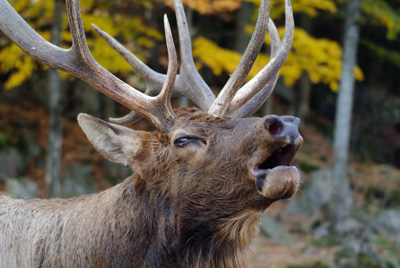Elk Sounds
An elk sounds like no other animal, and their unique vocalization is one of the things that makes it so exciting to hunt this big game species. As a hunter, your ability to imitate elk sounds could be the difference in whether you have elk stew, or tag soup. But before you can imitate, it’s important that you know what an elk sounds like.
Unless you have spent time in elk country, you may not even know what an elk sounds like. Even if you do, you may not realize that different sounds have different meanings. Here are descriptions of some of the main calls that you might hear while hunting, and that you may want to learn to imitate. There are many nuances around these elk calls, but these are the most important.
Bull Elk Bugle
By far the most well-known of all of the elk sounds, the Bull Elk Bugle is one of the defining characteristics of this species. The loud multi-tone call usually begins with a low frequency “growl” and progresses to a high pitched “scream” that is held for several seconds. Bull elk will bugle for multiple reasons. One of the main reasons is to announce their presence and to locate other bulls. While bulls may bugle at any time, this activity most commonly begins a few weeks before the rut and lasts a few weeks after the peak of the rut. Bulls may also bugle to attract a mate, warn other bulls to stay away, and as a display of dominance. Bulls can bugle so much during the rut that they get hoarse, or even get laryngitis. Be careful in jumping to conclusions about the size of an elk based on his bugle. A “monster” bugle can come from a relatively small bull, and a big bull can sound like he is a beginner bugler.
Bull Elk Chuckle
Often at the end of a bugle, a bull will emit a series of sharp sounds that sounds like a “chuckle”. Sometimes a bull will chuckle even without bugling. The reasons for chuckles are similar to those of bugles. At about 1:15 into the video above, a bull bugles with a classic chuckle at the end.
Bull Elk Glunking
Another interesting bull elk sound is called “glunking”. Coming from deep in the lungs, it sounds something like a bass drum sitting in water. Although not as common as bugles and chuckles, this sound can travel far due to the low frequency. It also serves some of the same purposes during the rut.
Cow Elk Sounds
This is the most common of elk sounds, since the majority of the elk herd consists of cows. The volume of cow elk sounds is typically a medium level when compared to bulls bugling or calves mewing. Cow elk call to their calves, other cows, and also to bulls.
Calf Elk Sounds
Calf elk sounds are very similar to the sounds that cows make. Calves call to their mothers as they keep track of each other while the herd is grazing or on the move. As one might expect, calf elk sounds are usually not loud, since they are smaller than their mothers.
Cow Elk in Estrus
This elk call is also known as a cow elk in heat. This is the sound a cow makes when she is ready to breed. At the peak of the rut, imitating this call can drive a bull crazy. This almost sounds like a “whine” as the call is carried on for longer the typical cow elk sound.
Elk Bark
A “Bark” is one of the elk sounds that you don’t want to hear. This is a warning to the other elk in the herd that an elk has seen something suspicious. It is a loud, single, sharp sound that sounds something like a dog bark, except from an elk. If you hear this sound, it’s highly likely that the herd will soon leave the area.
Elk Calls
Do you want information about the different types of elk calls that you can use when you are hunting? Check out my page on Elk Calls, or visit my blog post about My Favorite Elk Call.
Shopping for Elk Calls? Click Here To Shop a Huge Selection!




